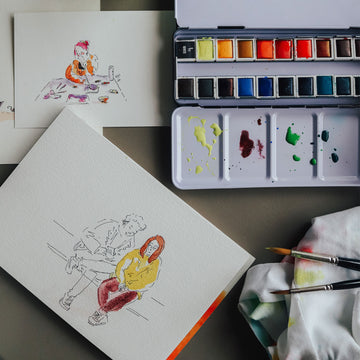I remember the first time I walked into a big art store – I felt like a little kid on Christmas Day! I got in, walked straight to the watercolour section and…
I was overwhelmed.
At the time, I knew nothing about how to pick watercolour paints. The sheer choice (and different price points) was way more than I could handle. Sure, the information was on the packaging, sometimes, but I had no idea what I was trying to read. It felt like a whole new foreign language, and it made me feel small.
Today’s blog post is about simplifying and curating the information you need to know to make an informed decision about what watercolour paints you’re getting.
Note: Our Kickstarter for our Watercolour Starter Kit has ended. You can now get it online!
Student Vs Artist Grade Supplies
You might find Student Grade watercolour sets that cost $15, and Artist Grade sets that go way above $80. So, what’s the big difference?
In one sentence, Student Grade is more affordable and lower quality supplies, meant for students or semi-pros, while Artist Grade is for professionals.
Read more details about Student vs Artist Grade quality supplies in this blog post. You can check out this article if you want a more in depth look on just the Student vs Artist Grade paints.
Within the Student Grade range, you can get extremely low quality or really great watercolour sets. It’s incredibly frustrating when you don’t know what you’re looking for, and it can feel a lot like playing the lottery.
Not all Student Grade supplies will tell you the information you need to know to make an educated selection of your watercolour set. My recommendation? Steer away from paints that don’t give you the information you need.
Lightfastness Rating
Lightfastness is the ability a dye or pigment has to endure light and retain its original colour over time. To sum up, the better the level, the more resistant the colour is to fading when exposed to sunlight.
There are different measurement levels for Lightfastness. We use the Blue Wool Scale chart, but there’s also the ASTM rating:

*Normal conditions of display: away from a window, under indirect sunlight and properly framed behind a UV protective glass.
The ASTM rating goes from I to V, and it goes like this:
- I: Level 7 and 8 of the Blue Wool Scale
- II: Level 6 of the Blue Wool Scale
- III: Level 4 and 5 of the Blue Wool Scale
- IV: Level 2 and 3 of the Blue Wool Scale
- V: Level 1 of the Blue Wool Scale
Of course, if you paint on 100% cotton, acid-free paper (like the paper in our sketchbooks), frame your paintings in acid-free materials, use UV-filtering glass and avoid direct exposure to sunlight, your paintings will last even longer.
Pigment information
Don’t you hate it when you’re in love with the ‘Sunflower Yellow’ from brand A, and then grab the ‘Sunflower Yellow’ from brand B and get a completely different colour?
This happens because the names given to colours are simply marketing names. So, how can you make sure you’re getting precisely the same colour?
The answer is: read the Colour Index Name. This lets you identify pigments clearly:
- The name starts with the letter ‘P’ to indicate a pigment (rather than a dye, ‘D’, or a basic dye, ‘B’).
- The letter ‘P’ is followed by another letter to denote one of ten basic colour categories: ‘Y’ for yellow, ‘R’ for red, ‘O’ for orange, ‘V’ for violet, ‘G’ for green, ‘B’ for blue, ‘Br’ for brown, ‘W’ for white, ‘Bk’ for black and ‘M’ for metallic.
See below an example where I'm comparing two different brands:

To sum up, if the ‘Sunflower Yellow’ from brand A was a PY3, then you can get precisely the same colour from another brand if you look at the Colour Index Name.
...In our watercolour set, that would be Lemon Yellow!
Note: Our Kickstarter for a new watercolour set has ended. You can now get it on our website!
Transparency Levels
Watercolours can be transparent or opaque. We also use the terms “semi-transparent” or “semi-opaque” for colours that are not as transparent or not as opaque.
Transparent watercolour paints sit on top of the paper and allow light to pass through them. But opaque watercolours allow little light to pass through.
Usually, transparent colours mix really with other transparent and even opaque watercolours. When mixed, opaque watercolours can cause a muddy effect. All this information is useful when planning layering or mixing.
Whether you use opaque or transparent watercolours depends on your process and what you want to accomplish with your paintings!

There’s a lot more to say and explore about watercolour properties, but we hope to have covered the essentials with this blog post.
What do you look for in watercolours?
Any stories you’d like to share? We’d love to hear your thoughts in the comment section below!




2 comments
Congratulations to whoever put together this page! It’s excellent.
For the transparency demo, I’ve always thought there should be both black AND white lines. The dark paints need the white.
Great explanation of pigment numbers. I’m so pleased that I have a handle on this now. I’ll be more confident about mixing and matching brands and knowing what Colour I’m going to end up with.
———
Etchr Lab replied:
So happy to hear this was helpful for you, Jay! 🧡